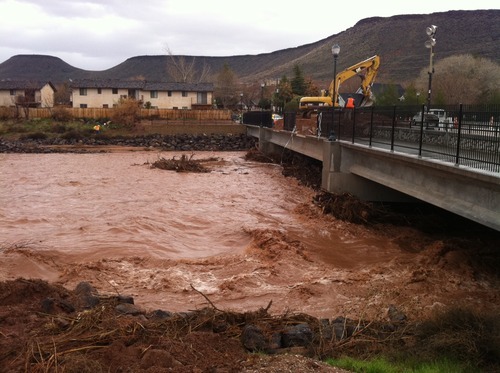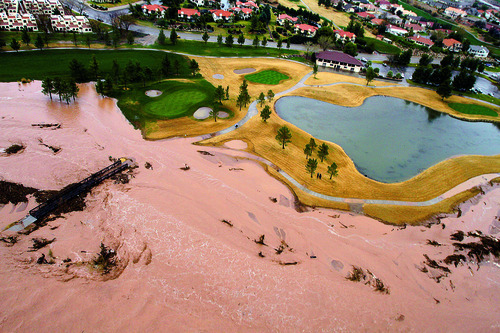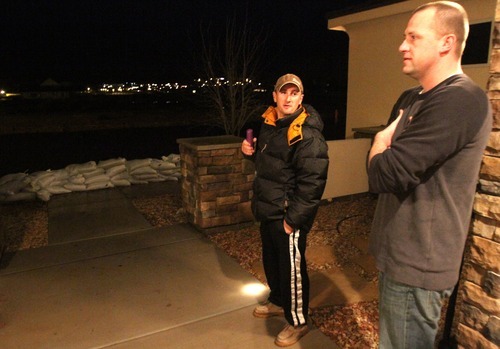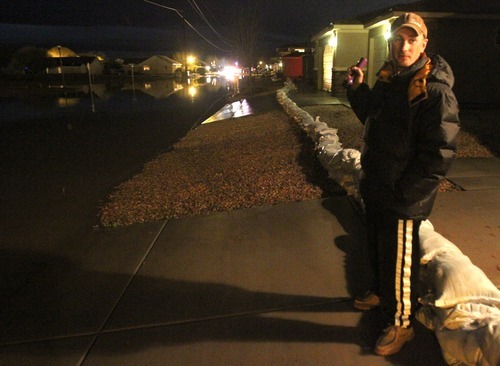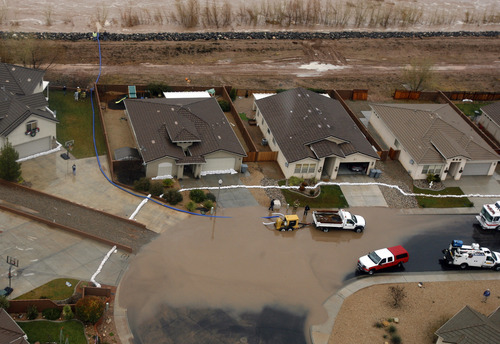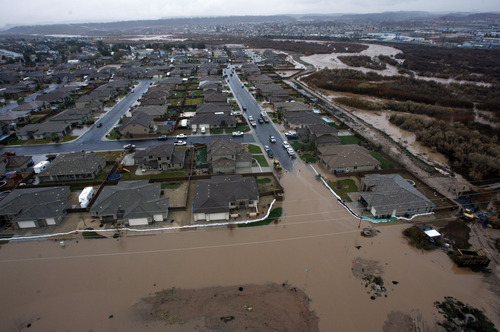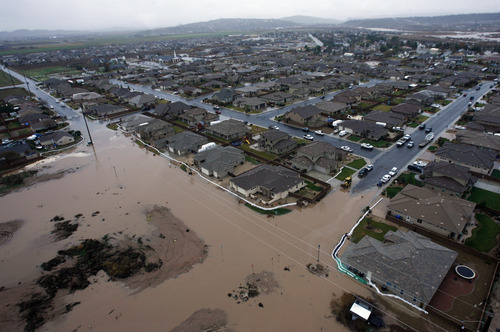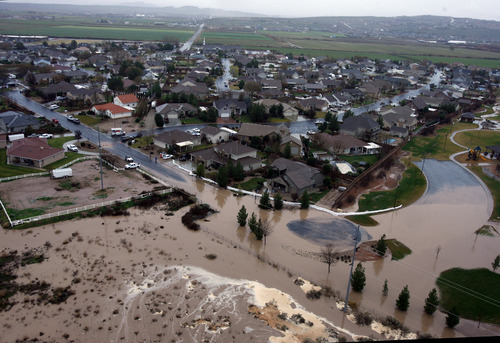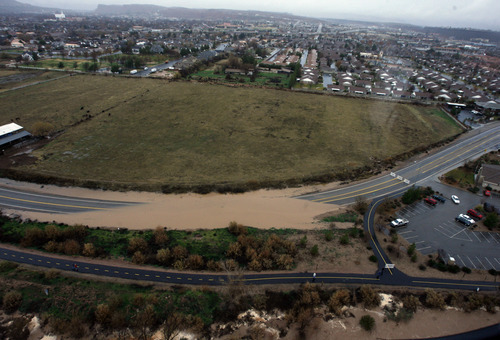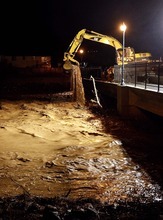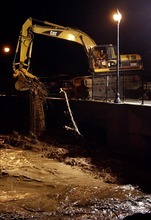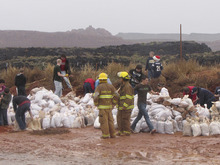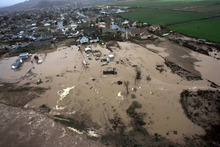This is an archived article that was published on sltrib.com in 2010, and information in the article may be outdated. It is provided only for personal research purposes and may not be reprinted.
St. George • On Dixie Downs Bridge Tuesday, Shirlene Joiret took pictures of the churning, muddy and very swollen Santa Clara River.
The scene reminded the St. George resident of the floods of 2005, when the river swept away bridges and several homes.
"I was hoping not to see this again," she said. "It's Mother Nature at her fullest. … I'm sad for all those affected by this."
The reinforced banks and new bridges at Dixie Downs and Valley View drives — rebuilt after the 2005 flooding — withstood the currents on Tuesday, but a threat on the Virgin River forced evacuations and resulted in the declaration of a state of emergency from two southern Utah governmental entities.
With more than 15,000 cubic feet of water per second already rushing down the banks of the Virgin River in northeast Washington County, a small leak at Trees Ranch Dam after noon spurred emergency officials into action.
The 86-foot-tall earthen dam above Springdale on the east fork of the Virgin River holds back 1,900 acre-feet of water. Washington County officials said if the dam were to break, it would affect everyone downstream as far as Mesquite, Nev. The dam had been inspected in April and was given a clean bill of health, but on Tuesday, it was exhibiting signs of failure.
"It is leaking," Washington County Sheriff Kirk Smith said Tuesday. "We have water coming through at the midpoint. And we are told that is not a good sign."
By about 2:30 p.m., more than 300 people — pretty much the entire town — were evacuated from their homes in Rockville.
For Filomena Diaz-Johnson, leaving meant taking a menagerie with her.
The owner of pet-boarding business Doggy Dude Ranch in Rockville said when she left, it was with about 20 dogs, four cats and an annoyed parrot that squawked its disapproval from a covered cage.
"I had to leave my [two] horses, but they are on high ground," she said.
With the aid of friends and some staff members, Diaz-Johnson had four vehicles to help transport the animals, along with their food and medicine to a friend's garage in Leeds until the evacuation is lifted.
She said sheriff's deputies went door-to-door asking residents to leave.
"We always had a plan prepared, but you never know if it is going to work," Diaz-Johnson said.
Rockville residents were told to gather at Hurricane Community Center at 50 S. 100 West.
Officials in Virgin, fearing the dam would fail, also asked people living on Water Street on the banks of the river to leave their homes.
Town firefighter Dustin Grow expected about 200 of the town's 500 residents would heed the call.
One who was willing to stick it out was Bryan Bird.
The Virgin resident was high up and a good distance from the river, so he wasn't too concerned.
"I was told to evacuate, but I'm staying put," said Bird, adding that the water was higher this time than in 2005.
At 4:45 p.m., Washington County officials said the dam would hold, but they will continue to monitor it. Safety experts from Cedar City and with the Governor's Office and state Department of Public Safety had examined the dam and said soil on it was running off but that its clay core appears to be stable.
By Tuesday evening, some of the evacuation orders had been lifted.
Even before the threat of the dam bursting, floodwaters were taking a toll. In the southwestern Utah town of Enterprise, portions of Utah 18 were covered with water. Flooding along Utah 9 forced closure of Zion National Park and the evacuation of Zion Lodge and Watchman Campground in Zion Canyon.
The tiny town of Gunlock was nearly isolated after floodwaters washed out the road leading to bridges north and south of town.
"There is significant erosion of the road at both ends of town," said Washington County emergency-operations spokesman Marc Mortensen.
Mortensen said the only way into Gunlock is on Sand Cove Road that is made of dirt and requires the use of a four-wheel-drive vehicle.
"We're asking that people stay off all dirt roads," he said.
St. George Mayor Daniel McArthur declared a state of emergency due to runoff and heavy rain in the city. County commissioners signed a declaration of disaster around 2:30 p.m., seeking money to battle the flooding.
"From what I hear, the worst of the storm is still ahead of us," said Washington County Commissioner Jim Erdley.
Despite the concerns of officials, St. George residents seemed intent on defying the raging waters. Crowds flocked to the rebuilt bridges to see how they were holding.
"This morning, you couldn't even find a place to park," said Barbara Bustamante of Valley View Bridge's popularity with gawkers.
Tuesday's high water reminded Bustamante of the 2005 floods, when "I watched appliances and pieces of houses float down the [Santa Clara] river."
In neighboring Santa Clara, firefighter Gabe Runolfson supervised a group of volunteers filling about 500 sandbags.
"We got a call from the Sixth Ward who said they had willing volunteers, and we said, 'OK, they can help all they want.' " Runolfson said the bags were being filled as a precaution and could be used wherever needed.
Gov. Gary Herbert was prepared to declare a state of emergency, but the disaster hadn't reached levels that would trigger a state declaration, the Governor's Office said.
"This community has been tested before and is responding as best as can be expected under these difficult circumstances," Herbert said.
Smith, the Washington County sheriff, said there have been improvements made since the 2005 floods.
"[The Virgin River] is flowing at what appears to be a more efficient manner," he said.
County Administrator Dean Cox agreed.
"The $60 million spent on armoring the banks to handle increased flows is paying huge dividends," he said. "The water is as high as [2005] that damaged so much infrastructure, but we could duck it this time."
Trees Ranch Reservoir is on private property and holds agricultural water. The Utah Division of Water Rights inspected it on April 27, according to state records.
The dam, known as the South Creek Dam in state records, received a clean bill of health, according to Judy Mattson of the Division of Water Rights.
The dam is rated "high hazard" by the state because of its proximity to downstream residents.
Washington County commissioners said they were told if the dam were to give way, it could double the depth of the Virgin River.
"It will exceed the biggest event we have ever had," Erdley said.
Mortensen said if the dam broke, water would move at about 7 to 10 mph and would take perhaps three hours to reach St. George.
The river was flowing at about 15,000 cfs on Tuesday afternoon and that a catastrophic failure of the dam would raise that rate to about 50,000 cfs, Cox said.
Mortensen said residents may follow @sgcitypubsafety or #wacoflood on Twitter to get up-to-the-second information on road closures and potential threats.
Farther south, the storm brought its share of trouble.
Four homes in the northwestern corner of Arizona were washed away by flooding after rains pounded the area Tuesday, and more houses were expected to be lost overnight, a fire chief said.
Mohave County, Ariz., declared an emergency because of flooding in the Beaver Dam and Littlefield areas.
The rain in the south was accompanied by heavy snow in northern Utah.
Utah County was hit hard early Tuesday, with some areas reporting a foot or more of snow. The storm forced Nebo School District to cancel all bus routes while initially leaving schools open, but classes were eventually canceled as the storm's intensity grew. Eastern Utah's Uintah School District decided to send students home at noon and canceled Wednesday classes.
Rocky Mountain Power crews moved to restore electrical service to more than 10,000 customers throughout the state Tuesday morning.
Park City Mountain Resort had a 24-hour total early Tuesday of 24 inches of new snow, while Solitude came in at 23 inches. Brighton reported 21 inches of new snow; Sundance got 19; Alta 18; Deer Valley 16; and The Canyons had 12 inches of new snow.
Christopher Smart and The Associated Press contributed to this report. The Utah Highway Patrol restricted Big and Little Cottonwood Canyons to chained or four-wheel drive vehicles only until Tuesday afternoon, while semis traveling westbound on Interstate 80 through the Wasatch Mountains were required to use chains. US-189 through Provo Canyon was experiencing intermittent closures due to the storm, while closures were ordered for SR-143 from Brian Head to Mammoth Creek Road; SR-14 from Cedar City to Long Valley Junction; SR-153 east of Beaver; and SR-9 through Zion National Park.
"We're urging people to just slow down out there," UHP spokesman Todd Johnson said. "Increase your following distance and exercise extra care when driving through the construction work areas — and clean all the snow off your windshields and windows."


